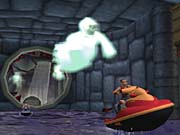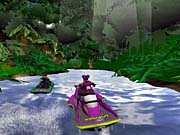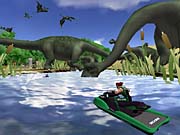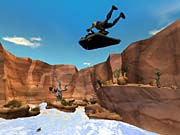Splashdown: Rides Gone Wild Q&A
We talk to Rainbow Studios about its upcoming PlayStation 2 racer.
The original Splashdown turned heads when it was released in 2001 for the PlayStation 2, thanks to its accessible gameplay and impressive water effects. The game was developed by Rainbow Studios, whose previous efforts include ATV Offroad Fury and Star Wars Racer Revenge, and it was eventually brought to the Xbox as well. The game's sequel, Splashdown: Rides Gone Wild, finds the burgeoning franchise undergoing a few changes. A new publisher, THQ, and revamped gameplay and graphics are taking the water-based racer into new territory. We recently talked to producer Mark Mahler, co-designer and co-lead programmer Adam Kraver, and co-designer Jordan Itkowitz from Rainbow to find out more about the promising game.

GameSpot: How long has the game been in development?
Mark Mahler: Preproduction and design started about 16 months ago, and we've been in full production for about 13 months. Pretty amazing, considering how large the game is and how much new stuff we're packing in.
GS: How big is the team working on it?
MM: About 30 people--Rainbow's biggest team so far.
GS: What is the team's background?
MM: The core team from the first Splashdown is back--both designers, our water and physics programmers, and myself. The art team on the first game wasn't all that big, but it's much bigger this time. Some worked on Star Wars Racer Revenge and Mat Hoffman's Pro BMX 2, and some are new to Rainbow (but not the industry).
GS: How satisfied was everyone with the original Splashdown? What went right? What could have gone better?
Adam Kraver: The first game turned out great. It was fun, fast, and beautiful, and it's still a blast to pick up and play today. We really wanted to readdress the waves on this one, though, and our level designs as well. We wanted to create a wilder, more exciting experience overall.
Now we've got huge waves you can get air off, dynamic waves that you can trigger off, downhill currents, and rapids. Basically, everything the critics and fans were asking for last time. As for the new courses, well, I'll let Jordan take this one.
GS: How did your feelings about the first game influence your approach to developing Splashdown 2?
Jordan Itkowitz: Last time, the course design was centered on real-world locations, and that can be limiting. This time, we wanted to let the concept dictate the gameplay, not some preconceived notion of what a location should or shouldn't be. Our most common phrase in design meetings was "Wouldn't it be cool if..." The courses just came from there. It was a very free, very open design process, and definitely a lot of fun.
Early on, we knew we wanted to do a lot of animated, dynamic events during the races, and then we hit on the whole theme-park/thrill-ride concept. We designed the courses as if you were racing through a huge elaborate ride at Disneyland. You know, big visual spectacle all around you, always something new to look at. Our courses aren't necessarily supposed to be thrill rides, but they were certainly developed with that experience in mind.

MM: Well, we've got two career modes: one for the eight world courses, which Jordan described above, and one for the 12 indoor stadium tracks. We had four stadium tracks in the first game, and they were pretty popular, so we created a lot more this time out. You can race these 20 courses in the circuit, time trials, and practice modes as well.
Technical time trials is a new mode with 20 courses that's for players who want to race the SeaDoos on open water without doing stunts or having to jump. They're small, open-ocean courses, about 30-45 seconds per lap, and it's all about mastering the lines and getting the best times. You can set the wave height in the UI, and the difficulty level will mark off your performance meter (which controls the range of your speed) at a set level. It's a very addictive, hypnotic race mode--you'll sit down to play a lap or two and then look up to see that you've gone around 20 times already. And then you say, OK, just one more. But you won't stop there.
Finally, there's the new freestyle mode. Six indoor tracks with pools stacked level upon level up to the ceiling, ramps and crisscrossing paths all over--they're pretty crazy. We have a huge stunt system this time, with 360 separate combos, and this event was tailor-made for it.
So, all in all, 46 separate courses, offering a lot of different racing gameplay experiences. There's definitely something for everyone.
GS: Can you walk us through the changes to the game's trick system?
JI: The basics: Pull off a stunt to add points to the performance meter, which boosts your speed and acceleration. Splashdown had about 30 separate stunts. This game has more than double that, but it also has a linking system. Low-level tier-one stunts branch into wilder tier-two stunts, which branch into the really acrobatic tier-three stunts. There are 120 possible chains with that system. That's not all, though--we've also added three new vehicle-based stunts (barrel roll, flat spin, and invert), and you can combine them with the rider stunts, taking our total number of chains to 360.
It's pretty cool when you go blasting off a ramp, pull off a double invert, and link that to a superman-kiss-of-death-back-handspring combo, or whatever else you decide to do. It's a fun, easy-to-learn system with a lot of room for experimentation.

AK: Our courses aren't terrain-based, like in the first Splashdown or ATV Offroad Fury. Instead, we're leveraging level building and animation techniques developed for some of our more recent titles, and we can now put together sprawling worlds that take you indoors as well as across open vistas. We've also got new shader technology and particle systems--lots of toys for the artists to play with.
Performance-wise, well, an average outdoor environment has about 300,000 polygons for the static environment. However, this doesn't include all our animated objects and characters, the SeaDoos, the riders, or the water. That would take us up to, uh...well, it's a lot. That's also at a solid 30fps, by the way.
GS: Could you tell us about the riders in the game?
JI: Five characters return from the first game: Andy, Haily, Kyoko, Jeremy (although he goes by the name Sha-Blamm!! now), and our resident favorite, Amman Ra. Three new characters join them, plus a number of secret guys. We have more than 1,000 lines of dialogue in this game, lots of funny stuff. It's been fun getting to know these characters over the past year, and the feeling is that since the team enjoys them so much, we hope everyone else will as well.
GS: Could you give us a rundown of the tracks in the game and the way they change dynamically? Why did you choose to emphasize that element?
JI: One of the fun things about racing games is checking out all the new environments. However, once you've seen an environment, you've seen it. Your third lap (not to mention your 23rd) is pretty much just like your first lap.
We wanted to do something different with this game, to let players discover something new around every corner, and to affect changes as well. Many of our outdoor courses take on a narrative arc of sorts--events you trigger off in lap one affect things that happen in laps two and three, changing the course and altering your experience.

For instance, on our Blackwater Castle course, you release a flood of ghosts from a haunted castle in lap one. During lap two, the ghosts attack a sleepy village, zombies pop out of the cemetery, and the villagers get riled up and march up to the castle (pitchforks, torches, and all). In lap three, they burn the castle down--while you're racing through it.
Some examples of big events you'll see in our other courses: glaciers crack and crash down in front of you in Polar Plunge; a dam bursts in Downtown Downpour, flooding a small Midwestern town; roaring rapids send you whipping through a narrow canyon and up into an abandoned mine loaded with TNT in Gold Rush Rapids; and a pirate ship rips free from its moorings, sails across a lagoon, and is blown apart by a Spanish fort in Cannonball Cove. Like I said, very cinematic and a lot of big "wow" moments.
GS: How did you approach the water physics in the game?
AK: There are two aspects to that question.
The first is the physics of the water itself. In essence, there are no physics. Our water is fully authored by the level builders and designers. This includes the basic water surface, incoming waves, and flowing water (downhill).
The physics of the water is really coded into the SeaDoo and how it interacts with the water. In order to get a fluid and lifelike, yet playable, interaction with the water, we have a pretty sophisticated physics engine that is based upon the real dynamics of a SeaDoo watercraft. We then add a layer of physics that tweaks the behavior of the SeaDoo to make it more manageable and fun for the player to drive without sacrificing the dynamic feel of racing a watercraft.
GS: Thanks for your time.
Got a news tip or want to contact us directly? Email news@gamespot.com
Join the conversation